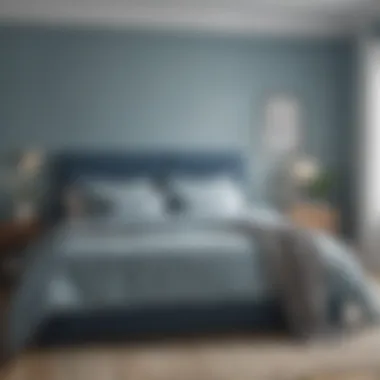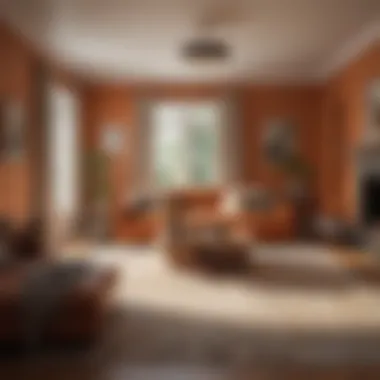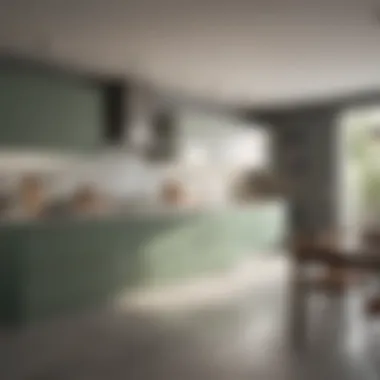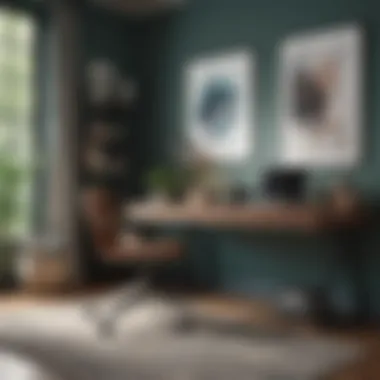Elevate Your Space: Expert Interior Paint Color Tips


Intro
Selecting the perfect interior paint color is a nuanced decision, one that blends artistry with psychology. The choices we make in color have the potential to transform a room, not just aesthetically but emotionally. A serene blue can evoke calmness, while a vibrant yellow might stimulate energy. Thus, understanding the implications of color selection is fundamental for anyone looking to enhance their living spaces. This guide aims to provide practical recommendations based on the psychological effects of color, while also aligning with current trends that appeal to sophisticated tastes.
Understanding Color Psychology
The psychology of color is a fascinating field. It examines how various hues affect our feelings and behaviors. For instance, warm colors, such as oranges and reds, can create a sense of warmth and coziness, making them ideal for gathering spaces like living rooms. On the other hand, cool colors, including blues and greens, tend to foster tranquility—making them a fitting choice for spaces such as bedrooms or subtle work areas.
It's crucial to note that personal responses to color may vary. Therefore, one must consider the individual or family dynamic while choosing colors to ensure a pleasing environment.
Practical Recommendations for Different Rooms
Living Room
For the living room, consider a rich taupe or soft gray. These neutral tones create an inviting atmosphere while allowing for flexibility in furniture and decor choices.
Color contrast also adds interest; incorporating an accent wall can bring a focal point to the room. For example, deep navy can serve as an accent against lighter shades.
Bedroom
Opt for calming colors. Shades like soft lavender or light blues can promote better sleep. A deeper shade of green can also instill a sense of peace.
Kitchen
The kitchen can benefit from brighter colors, like pale yellows or greens. These tones can stimulate appetite and promote energy. Additionally, lighter colors can help make smaller kitchens appear larger and more open.
Home Office
For a productive work environment, muted tones such as soft browns or cool blues may enhance focus and creativity. Consider a warm accent color for your workspace to stimulate energy without overwhelming the space.
Current Trends in Color Choice
Interest in specific color trends tends to ebb and flow. Currently, there is a notable preference for earthy tones: soft greys, muted greens, and warm yellows have become increasingly popular. Additionally, the trend of monochromatic schemes allows for dramatic contrast and elegant simplicity.
Incorporating patterns and textures in paint can also create depth—textured finishes or intricate wall treatments engage the eye without overpowering the surroundings.
"Color is a power which directly influences the soul." - Wassily Kandinsky
End
Selecting an interior paint color is not merely a choice of aesthetics; it's a statement about who you are and how you want your spaces to feel. By understanding the psychological effects of color, making informed decisions tailored to specific rooms, and staying aware of trends, one can transform any space into a peaceful and inspiring environment.
Understanding Color Theory
Understanding color theory is crucial for making informed decisions in interior paint color selection. It provides the foundation for how colors interact, influence perceptions, and affect moods. Knowledge in this area not only aids in enhancing the aesthetic appeal of an environment but also plays a significant role in creating atmospheres that align with the intended function of each space. Colors can evoke emotions, and recognizing their impact allows one to tailor interiors suited to personal taste and lifestyle needs.
When selecting paint colors, various elements come into play. This includes knowing the basics of the color wheel, understanding color temperatures, and recognizing the psychological effects of colors. Each of these components contributes to a harmonious and well-thought-out design scheme.
The Basics of the Color Wheel
The color wheel is a visual representation that categorizes colors in a circular format. It consists primarily of three primary colors: red, blue, and yellow. These colors can be combined to create secondary colors—green, orange, and purple. From these secondary colors, one can form tertiary colors, which provide a broader palette to work with.
Familiarity with the color wheel allows for effective combinations. For instance, complementary colors, which are opposite each other on the wheel, create striking contrasts. On the other hand, analogous colors, which sit next to each other, can convey harmony.
Key points about the color wheel:
- Primary Colors: Red, blue, yellow - cannot be created by mixing.
- Secondary Colors: Orange, green, purple - formed by mixing primary colors.
- Tertiary Colors: These are achieved by mixing primary colors with secondary ones,
- Color Harmony: Understanding combinations help achieve a balanced aesthetic.
Color Temperature: Warm vs. Cool


Colors are often categorized as warm or cool. Warm colors include reds, oranges, and yellows, which can create a sense of warmth and energy. Cool colors, such as blues, greens, and purples, evoke calmness and serenity. Each type of color can significantly impact how a room feels.
For example, warm colors are often favored in social spaces, such as living rooms, as they encourage interaction and create vibrancy. Cool colors, contrastingly, are popular in bedrooms or bathrooms, where relaxation and tranquility are the priorities.
A practical consideration is to assess how natural and artificial light may alter these perceptions. A warm-toned space might feel inviting under soft lighting but may appear harsh under bright fluorescent lights.
The Psychology of Color
The psychological effects of color are profound and can influence mood and behavior within a space. Studies show that specific colors evoke certain feelings and reactions.
- Blue: Promotes calmness and is often used in offices for its focus-enhancing properties.
- Red: Known for stimulating energy; great for dining areas but can be overwhelming in large quantities.
- Green: A restful color, it symbolizes nature and can relieve stress.
- Yellow: Invokes happiness but, if overused, can lead to feelings of agitation.
- Purple: Often associated with luxury and sophistication but may seem heavy in large amounts.
"Color carries the greatest power in a space; it shapes our perception and therefore our realities."
Being aware of these psychological aspects allows for intentional choices that align with the expectations and functions of each room. A well-curated palette can enhance the overall experience of living and working spaces.
Choosing Colors for Different Rooms
Selecting the right paint colors for each room in a home is crucial for establishing the intended mood and functionality of the space. Every room serves a distinct purpose and, as such, requires a careful selection of colors that complement that purpose. Different colors can influence how a person feels in a space, making it vital to understand the best choices based on the activities that will take place in each area.
When choosing colors for different rooms, one must consider elements such as lighting, size of the room, and the overall design aesthetic of the home. It's not merely about aesthetics; it involves psychological effects and personal preferences that contribute to the experience of the space. The goal is to create an environment that enhances comfort and promotes the intended activities, whether that be relaxation in a bedroom or creativity in a home office.
Living Room: Creating a Welcoming Atmosphere
The living room is often the heart of the home, where families gather and guests are entertained. This space should exude warmth and hospitality. Selecting colors like soft beige, muted greens, or warm taupes can create an inviting atmosphere. Using neutral tones can also provide a blank canvas for decor elements, allowing for occasional pops of color through art, furniture, or accessories.
Consider the lighting in the living room as it can significantly alter how colors appear. Natural light brings out the true essence of hues, while artificial light may warm up or cool down a color. Choosing a color that maintains its character in both lighting settings ensures a cohesive appearance throughout the day.
Kitchen: Invigorating and Inviting Tones
A kitchen is not only a space for cooking but also a gathering place for family and friends. It benefits from invigorating colors that inspire energy and creativity. Light, cool colors such as soft blues and yellow can make the kitchen feel fresh and clean. Alternatively, deeper shades like navy blue can lend an air of sophistication when paired with crisp white cabinetry.
In this setting, choosing paint that can withstand splatters and stains is essential. The kitchen often sees a lot of activity, so considering a durable satin or semi-gloss finish could be advantageous.
Bedroom: Establishing Serenity and Restfulness
The bedroom is a sanctuary for rest and tranquility. Therefore, soft, calming colors like pale blues, gentle lavenders, or muted earth tones are ideal choices. These colors tend to soothe the mind and promote relaxation. The key in this space is to create a backdrop that allows for restful sleep and recovery.
Using darker shades strategically can create a cozy feel, especially when balanced with lighter bedding and furnishings. Ensuring that the color scheme is cohesive with other elements in the room, such as textiles and wall art, can enhance the overall peaceful ambiance.
Bathroom: Fostering a Spa-like Ambiance
In recent years, bathrooms have transitioned into personal retreats. To foster that spa-like feel, consider using serene colors like soft grays, crisp whites, or light greens. These hues evoke cleanliness and relaxation, transforming the bathroom into a space of pampering.
Textures also play a crucial role. Combining paint with natural materials such as wood or stone can elevate the design, creating a complete sensory experience. In smaller bathrooms, lighter shades can make the space appear larger and more open.
Home Office: Enhancing Focus and Productivity
A home office demands colors that stimulate focus and productivity. Soft greens or muted blues are excellent choices, as they tend to promote concentration without being too overwhelming. Avoid bold colors that could become distracting; instead, select hues that create a sense of calm and efficiency.
It is also beneficial to incorporate elements like accent walls or strategic lighting to delineate the work area and create a productive environment. Choosing the right color will support the financial success and decision-making abilities that come from sharp focus and clarity.
"Color is the keyboard, the eyes are the harmonies, the soul is the piano with many strings." - Wassily Kandinsky
Current Trends in Interior Paint Colors
Understanding the current trends in interior paint colors is essential for anyone looking to create a sophisticated space. These trends not only reflect the aesthetic preferences of today’s designers but also indicate broader societal shifts and influences. By staying attuned to these trends, a homeowner or designer can ensure that their choices remain relevant and appealing in a fast-changing market.
Current trends can also provide inspiration for personalizing spaces. It is not just about following a fad; it’s about integrating elements that resonate with one's style while ensuring cohesion across different areas in the home.


Color of the Year Selections
Each year, paint companies announce their "Color of the Year" selections, setting the tone for interior designs across various settings. For 2023, some notable color choices include deep green, warm terracotta, and soft lavender.
These selections are derived from extensive research into societal trends, lifestyle changes, and emotional responses to colors. Deep greens offer a sense of calmness, while terracotta evokes warmth and connection to nature. Soft lavender, on the other hand, adds a touch of tranquility, making it ideal for restful spaces.
Selecting one of these colors for key areas can enhance the mood and atmosphere effectively.
Monochromatic Schemes for Modern Spaces
Monochromatic schemes remain a favored trend in modern interior design. This approach involves using varying shades, tints, and tones of a single color throughout a space. The result is a harmonious and cohesive look.
The benefit of this trend lies in its simplicity and elegance. Monochromatic color palettes can create a serene environment. When done thoughtfully, it can draw attention to textural elements and furniture, allowing them to take center stage without clashing with bold colors.
When selecting a monochromatic palette, consider a primary color that resonates with the overall vibe you want to achieve while ensuring the space feels inviting and stylish.
Bold Colors for Accent Walls
Bold colors for accent walls continue to gain traction in contemporary design. This approach allows for a dramatic focus within a room without overwhelming the overall ambiance. Colors like navy blue, emerald green, and rich burgundy are popular choices for accent walls.
An accent wall can serve as a backdrop for artwork or a statement piece of furniture, drawing the eye and creating a focal point. The contrast created with surrounding lighter colors helps to energize the space, making it feel dynamic yet sophisticated.
To execute this trend effectively, it’s important to assess the balance of colors within the room, ensuring that the bold choice complements rather than competes with existing decor.
Earthy Tones and Nature-Inspired Palettes
The trend toward earthy tones and nature-inspired palettes reflects a growing desire to connect indoor spaces with the natural world. Colors such as sandy beige, soft browns, and muted greens provide a grounding influence in any setting.
These tones can evoke feelings of peace and comfort, making them ideal for living spaces and relaxation zones. They are versatile and can be paired with various textures and fabrics, enhancing the organic feel of a room. By integrating natural colors, homeowners can create an environment that feels more airy and open, promoting overall well-being.
Practical Considerations in Color Selection
Selecting the right paint color goes beyond simply choosing a shade that looks appealing. This section highlights the practical considerations that should guide such choices. Understanding these aspects can lead to a more fulfilling and visually appealing outcome. Practical considerations include how light interacts with color, the perception of color in relation to the size of a room, and finding the balance between current trends and lasting style.
These factors can make or break the overall design aesthetic. Failing to consider them can result in dissatisfaction and a mismatch between intention and reality in your living spaces.
Lighting: How Natural and Artificial Light Affects Color
One must acknowledge the significance of lighting when choosing paint colors. Both natural and artificial light sources affect color perception. Natural light, especially, changes throughout the day. A color that appears vibrant in morning light might look muted by evening.
Consider these points:
- Direction of light: North-facing rooms might show cooler, muted colors, while south-facing options can make warmer tones appear more vibrant.
- Light bulbs quality: Different bulbs emit varying temperatures of light. Incandescent bulbs produce a warm glow, creating an inviting atmosphere, whereas fluorescent light can render colors more stark and sometimes unflattering.
To assess color under different lighting conditions, it is useful to paint a small patch on the wall and observe it at various times. This helps in making a more informed decision, leading to a space that feels cohesive and well thought-out.
Room Size and Color Perception
Next, consider the room's size when selecting paint colors. Color can manipulate visual space significantly. Lighter colors often make a room appear larger, while darker shades can add depth but may feel restricted.
Key Points to Remember:
- Light colors: Soft whites, pale blues, and light grays can make small rooms feel more expansive. This is especially useful in compact areas like bathrooms.
- Darker colors: Deep hues can create an intimate atmosphere but should be used wisely in tighter spaces to avoid feeling claustrophobic.
- Accent colors: Utilizing a bold color on one wall can give depth to the room, breaking the monotony without overpowering the overall design.
Understanding how colors interact with room size will help in creating a harmonious environment conducive to relaxation and enjoyment.
Trends vs. Timelessness: Balancing Fashion with Endurance
In the world of interior design, trends come and go. Therefore, finding a balance between trendy choices and timeless elegance is critical for lasting satisfaction. While embracing current design movements can lead to fresh appeal, an over-reliance on fleeting trends might render a space outdated quickly.


Some strategies include:
- Choosing a neutral base: This allows for easy updates with accessories or accent walls that reflect current trends.
- Incorporating trendy elements thoughtfully: One can select trendy shades for smaller rooms or accessories, minimizing risks and maintaining flexibility in future decor decisions.
- Timeless colors: Shades like soft cream, deep navy, or muted greens often endure through the years, providing a foundation for various styles.
By considering both current trends and timeless colors, individuals can create a space that feels modern yet enduring, fulfilling both aesthetic and practical needs.
Tools and Techniques for Choosing Paint Colors
Choosing the right paint colors for interiors can significantly impact a space’s atmosphere and appeal. The tools and techniques available streamline the decision-making process, making it easier and more precise. Leveraging these methods not only aids in visualizing the final outcome but also enhances the overall experience of color selection.
Using Color Samples Effectively
Color samples are essential when selecting paint. Many paint stores provide small swatches that allow homeowners to see how a color appears in their specific environment. When using color samples, consider these tips:
- Lighting Conditions: Examine the sample under different lighting. Colors can look starkly different in natural light compared to artificial light.
- Size Matters: Use larger sample patches rather than tiny swatches. This gives a better representation of how the color will cover the area.
- Test at Home: Apply samples on the wall to get a real sense of how the color interacts with other elements in the room.
Utilizing color samples effectively minimizes surprises during the actual painting process. This informed decision reduces the likelihood of needing to repaint, saving both time and resources.
Digital Tools for Virtual Color Visualization
In today’s digital age, technology offers creative tools to visualize paint choices. Various applications can simulate how a selected color will look on walls, thus eliminating guesswork. Some notable benefits include:
- Instant Feedback: Users can rapidly test multiple colors without commitment or mess.
- Integration Features: Many digital tools allow users to combine colors and see how they work together before making a choice.
- Access to Trends: These platforms often keep users updated with current color trends in real time, ensuring relevance in choices.
Applications like Sherwin-Williams’ ColorSnap and Benjamin Moore’s Personal Color Viewer are popular among designers and homeowners alike. They enhance creativity while assisting in making informed decisions.
Consulting Professionals: When to Seek Expert Help
While many may approach color selection independently, there are instances when consulting professionals proves beneficial. Interior designers or color consultants bring expertise that can elevate a project.
- Expertise in Trends: Professionals often have extensive knowledge of current trends, helping clients choose colors that reflect their personal style while staying contemporary.
- Understanding Space: A professional can assess a space's architecture and lighting, ensuring color choices amplify its strengths.
- Complex Projects: For larger renovations or unique spaces, their insights can avoid common pitfalls and mistakes.
In summary, recognizing when to seek expert advice can save time and enhance the overall aesthetics of a space.
Consulting professionals leads to a more cohesive and aesthetically pleasing result, which adds value to any interior project.
Final Thoughts on Interior Paint Recommendations
Choosing the right interior paint colors goes beyond mere aesthetics. It plays a crucial role in defining the atmosphere and functionality of a space. Understanding the psychological impact of color, the nuances of light and shadow, and the interplay between personal taste and current trends can culminate in a harmonious environment—one that feels just right.
A significant benefit of making informed color choices is the creation of spaces that truly reflect individual identities. Every homeowner can think of colors as more than visual options; they are expressions of personality and lifestyle. Likewise, with considerations of different rooms’ purposes, one can facilitate desired moods, enhancing enjoyment and comfort.
The Value of Personal Preference in Color Choices
Personal preference should be at the forefront of any color selection process. What resonates with one individual may not with another. This subjective element is essential to consider in designing living spaces. If a certain hue brings comfort or joy, it deserves attention.
When selecting paint colors, ask:
- What emotions does the color evoke?
- How does it coordinate with existing furnishings?
- Does it align with the lifestyle and preferences of the inhabitants?
This reflective approach leads to more satisfying results. Thoughtful consideration of personal preferences fosters an environment that feels genuine and inviting.
Emphasizing Cohesion in Overall Design
Cohesion is vital in interior design. When selecting colors, it’s crucial to think about how each choice integrates into the larger design scheme. Color consistency, from room to room, contributes to an overall flow.
To achieve this cohesion, consider:
- Establishing a color palette: Choose complementary colors for different rooms to maintain visual harmony.
- Using accents wisely: Bold accent colors can create focal points but should be carefully balanced against the base colors.
- Maintaining theme: Align paint choices with architectural style and existing elements, such as furniture, to achieve seamless integration.
Achieving cohesion means that every element in a space, from colors to furnishings, contributes to a unified vision. In this way, the home becomes a curated experience, elevating the overall aesthetic.
"The right color scheme can transform a house into a personalized home that echoes the inhabitants’ soul."
In summary, interior paint selections encapsulate not just style, but a convergence of personal expression and practical design language. Finding that delicate balance ensures spaces resonate with beauty and purpose.







